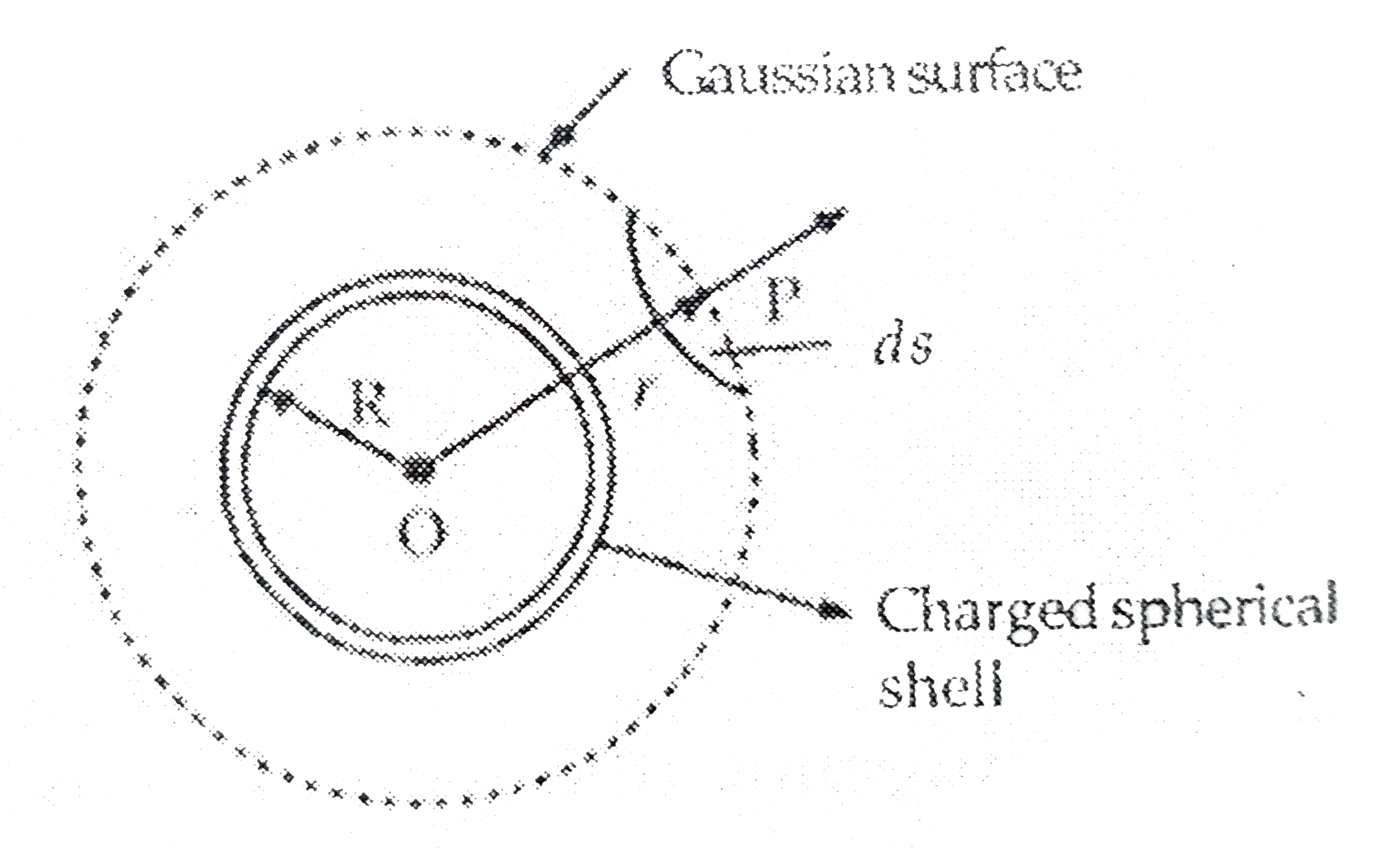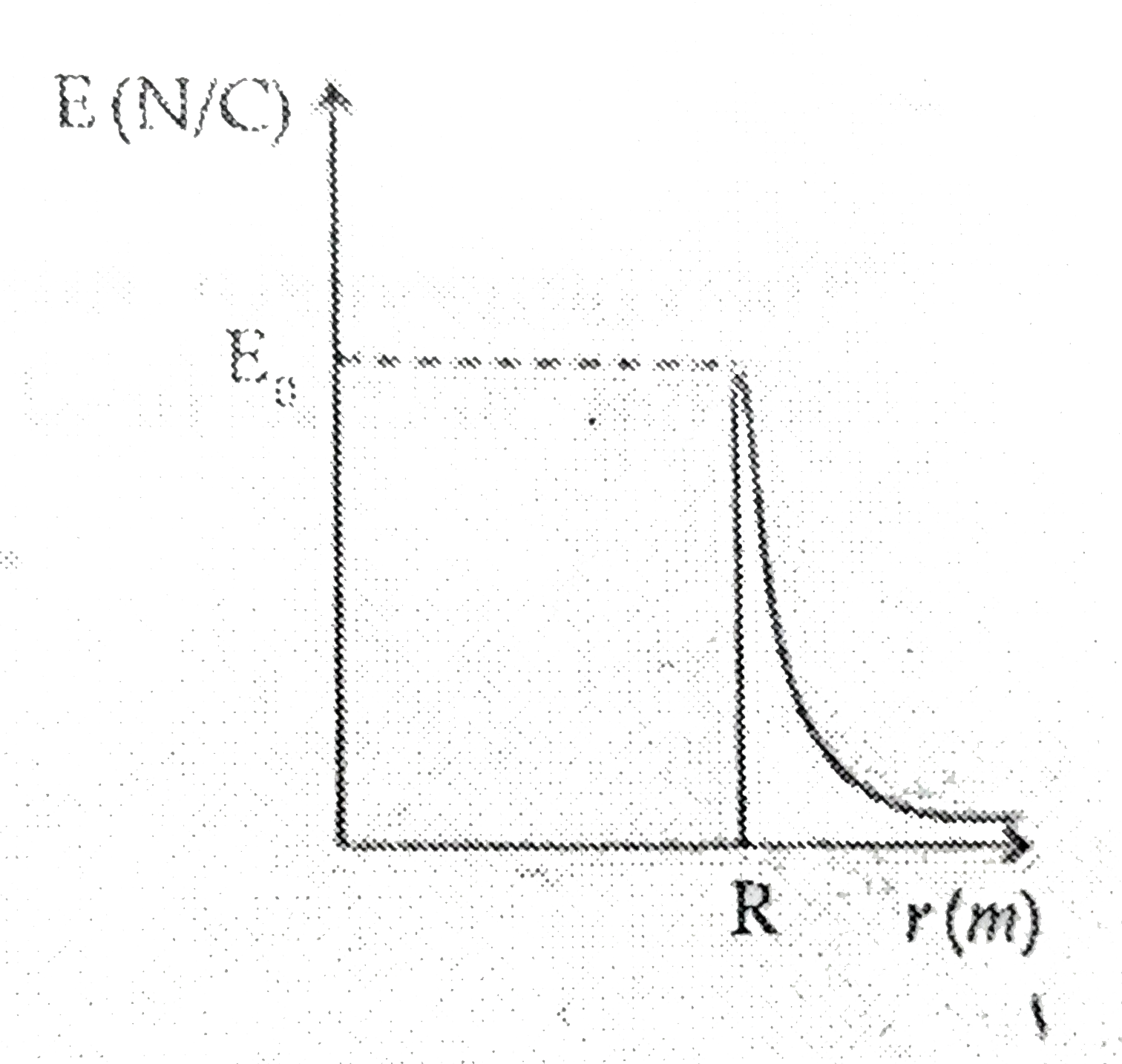Using Gauss' law deduce the expression for the electric field due to a uniformly charged sperical conducting shell of radius R at a point (i) outside and (ii) inside the shell.
Plot a graph showing variation of electric field as a function of r>Randr<R. (r being the distance from the centre of the shell)
Electric field due to a uniformly charged thin spherical shell -
(i) When point P lies Outside the Spherical Shell - Suppose that we have to calculate electric field at the point P at a distance r(r>R) from its centre. Draw the Gaussian surface through point P so as to enclose the charged spherical shell of radius r and centre O.
Let →E be the electric field at point P. Then, the electric flux through area element →ds is given by,
dϕ=→E.→ds
Since →ds is also along normal to the surface,
dϕ=Eds
∴ Total electric flux through the Gaussian surface is given by,
ϕ=∮Eds=E∮sds
Now,
∮ds=4πr2
∴ ϕ=E×4πr2 ...(i)
Since the charge enclosed by the Gaussian surface is q, according to Gauss theorem,
ϕ=qε0 ...(ii)
From equations (i) and (ii), we get
E×4πr2=qε0
E=14πε0.qr2 (for r>R)

(ii) When point P lies inside the spherical shell : In such a case the Gaussian surface encloses no charge
According to Gauss Law,
E×4πr2=0
i.e., E=0(r<R)
Graph showing the variation of electric field as a function of r.

Related Playlists
- BOOK - XII BOARDS PREVIOUS YEARCHAPTER - XII BOARDSEXERCISE - SET-II35videos
XII BOARDS
- BOOK - XII BOARDS PREVIOUS YEARCHAPTER - XII BOARDSEXERCISE - SET-III25videos
XII BOARDS
- BOOK - XII BOARDS PREVIOUS YEARCHAPTER - XII BOARDSEXERCISE - SET III9videos
XII BOARDS
- BOOK - XII BOARDS PREVIOUS YEARCHAPTER - SAMPLE PAPER 2019EXERCISE - SECTION D6videos
SAMPLE PAPER 2019
Similar Questions
Using Gauss' law deduce the expression for the electric field due to uniformaly charged spherical conducting shell of radius R at point (i) outside ,and (ii) inside the shell.
Plot a graph showing variation of electric field as a functions or r for r< R and .(r being the distance from the centre of the shell).View SolutionUsing Gauss's law obtain the expression for the electric field due to uniformly charged thin spherical shell of radius R at a point outside the shell. Draw a graph showing the variation of electric tield with r, for r gt R and r lt R.
View SolutionUsing Gauss's law obtain the expression for the electric field due to uniformly charged thin spherical shell of radius R at a point outside the shell. Draw a graph showing the variation of electric tield with r, for r gt R and r lt R.
View SolutionUsing Gauss's law obtain the expression for the electric field due to uniformly charged thin spherical shell of radius R at a point outside the shell. Draw a graph showing the variation of electric tield with r, for r gt R and r lt R.
View SolutionFind the gravitational potential due to a spherical shell of mass M and radius R at r<R and r>R, where r is the distance from the centre of the shell.
View SolutionFind the gravitational potential due to a spherical shell of mass M and radius R at r<R and r>R, where r is the distance from the centre of the shell.
View SolutionUsing Gauss’s theorem in electrostatics, deduce an expression for electric field intensity due to a charged spherical shell at a point (i) inside (ii) on its surface (iii) outside it. Graphically show the variation of electric field intensity with distance from the centre of shell.
View SolutionDraw a graph of electric field E(r) with distance r from the centre of the shell for 0≤r≤0 .
View SolutionWhich of the following graph represents the variation of electric field E due to a thin charged spherical shell of radius R as a function of the distance r from the centre of the shell?
View SolutionA metallic spherical shell of radius R has a charge -Q on it. A point charge +Q is placed at the centre of the shell. Which of the graphs shown below may correctly represent the variation of electric field E with distance r from the centre of shell ?
View Solution

